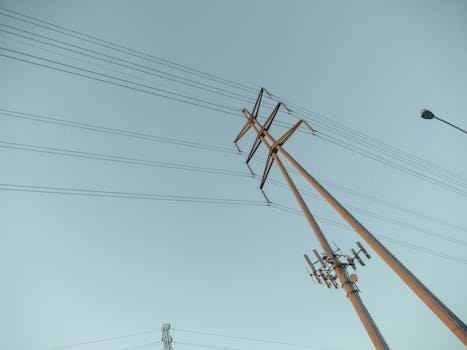“Empower Your Home: Mastering Grid-Tie Solar System Wiring for Sustainable Energy.”
Wiring a solar system for grid-tie applications involves connecting solar panels, an inverter, and the electrical grid to enable the generation of renewable energy while allowing for the sale of excess power back to the utility. This process requires a clear understanding of electrical systems, safety protocols, and local regulations. Proper wiring ensures efficient energy transfer, system reliability, and compliance with grid standards. This guide will outline the essential components, wiring techniques, and best practices for setting up a grid-tied solar system, enabling homeowners and businesses to harness solar energy effectively.
Understanding Grid-Tie Solar System Components
Understanding the components of a grid-tie solar system is essential for anyone looking to harness solar energy effectively. At the heart of this system lies the solar panels, which are responsible for converting sunlight into electricity. These panels are typically made up of photovoltaic (PV) cells that generate direct current (DC) electricity when exposed to sunlight. The efficiency and output of these panels can vary based on factors such as the type of technology used, the angle of installation, and the amount of sunlight received throughout the year. Therefore, selecting high-quality solar panels that suit your energy needs is crucial for optimizing performance.
Once the solar panels generate electricity, the next component in the grid-tie system is the inverter. This device plays a pivotal role by converting the DC electricity produced by the solar panels into alternating current (AC) electricity, which is the form of electricity used by most household appliances and the electrical grid. There are different types of inverters available, including string inverters, microinverters, and power optimizers. String inverters are commonly used in residential systems, as they are cost-effective and easy to install. However, microinverters and power optimizers can enhance energy production in situations where shading or varying panel orientations are a concern. Understanding the specific advantages and limitations of each inverter type is essential for making an informed decision.
In addition to solar panels and inverters, a grid-tie solar system also requires a connection to the electrical grid. This connection allows homeowners to feed excess electricity generated by their solar panels back into the grid, often resulting in credits on their utility bills through net metering. This arrangement not only maximizes the financial benefits of solar energy but also contributes to a more sustainable energy ecosystem. However, it is important to comply with local regulations and utility requirements when establishing this connection, as each utility company may have different policies regarding interconnection and net metering.
Another critical component of a grid-tie solar system is the monitoring system. This technology enables homeowners to track the performance of their solar panels and inverters in real-time. Monitoring systems can provide valuable insights into energy production, consumption patterns, and system efficiency. By analyzing this data, homeowners can identify potential issues early on, ensuring that their solar system operates at peak performance. Many modern monitoring systems offer smartphone applications, making it convenient for users to stay informed about their energy generation and usage.
Moreover, while grid-tie systems do not typically require batteries, some homeowners may choose to incorporate battery storage for added resilience. Although batteries can increase the initial investment, they provide backup power during outages and allow for energy use during peak demand times. This can be particularly beneficial in areas prone to power interruptions or for those who wish to maximize their energy independence.
In conclusion, understanding the components of a grid-tie solar system is fundamental for anyone considering solar energy. From solar panels and inverters to grid connections and monitoring systems, each element plays a vital role in ensuring the system operates efficiently and effectively. By carefully selecting and integrating these components, homeowners can not only reduce their energy costs but also contribute to a cleaner, more sustainable future. As the demand for renewable energy continues to grow, becoming familiar with these components will empower individuals to make informed decisions about their energy choices.
Step-by-Step Guide to Wiring a Grid-Tie Inverter

Wiring a solar system for grid-tie applications involves several critical steps that ensure both safety and efficiency. To begin with, it is essential to understand the components involved in a grid-tie system, which typically includes solar panels, a grid-tie inverter, and the necessary wiring and safety equipment. The grid-tie inverter plays a pivotal role, converting the direct current (DC) generated by the solar panels into alternating current (AC) that can be fed into the electrical grid.
First, you should gather all the necessary tools and materials. This includes the solar panels, grid-tie inverter, appropriate wiring, circuit breakers, and safety equipment such as gloves and goggles. Before starting the installation, it is crucial to review local electrical codes and regulations, as these can vary significantly and may dictate specific requirements for grid-tie systems. Once you have ensured compliance with local regulations, you can proceed with the installation.
The first step in wiring the system is to mount the solar panels securely on the roof or another suitable location. It is vital to position the panels to maximize sunlight exposure, typically facing south in the northern hemisphere. After securing the panels, you will need to connect them in series or parallel, depending on the desired voltage and current output. Connecting panels in series increases voltage, while connecting them in parallel increases current. It is essential to calculate the total voltage and current to ensure compatibility with the inverter.
Once the panels are connected, the next step is to run the wiring from the solar panels to the grid-tie inverter. Use appropriate gauge wire to handle the current load, and ensure that all connections are secure and weatherproofed to prevent any potential issues. As you route the wiring, be mindful of any sharp edges or potential hazards that could damage the insulation. It is also advisable to use conduit to protect the wiring from environmental factors.
After the wiring is in place, you can connect the solar panel output to the input terminals of the grid-tie inverter. At this stage, it is crucial to follow the manufacturer’s instructions carefully, as improper connections can lead to system failure or safety hazards. Ensure that the inverter is equipped with the necessary safety features, such as overcurrent protection and anti-islanding capabilities, which prevent the inverter from feeding power back into the grid during outages.
Following the connection of the solar panels to the inverter, the next step is to connect the inverter to your home’s electrical system. This typically involves connecting the inverter’s AC output to your main electrical panel. It is advisable to install a dedicated circuit breaker for the inverter to ensure that it can be easily disconnected for maintenance or in case of an emergency. As you make these connections, double-check that all wiring is correctly insulated and secured to prevent any electrical hazards.
Finally, once all connections are made, it is time to power up the system. Before doing so, conduct a thorough inspection to ensure that all components are correctly installed and that there are no loose connections. After confirming everything is in order, turn on the inverter and monitor its performance. It is essential to familiarize yourself with the inverter’s display and settings, as this will allow you to track the system’s efficiency and troubleshoot any issues that may arise.
In conclusion, wiring a solar system for grid-tie applications requires careful planning and execution. By following these steps and adhering to safety protocols, you can successfully set up a grid-tie inverter that harnesses solar energy efficiently while contributing to your energy needs and reducing your carbon footprint.
Safety Considerations When Wiring a Solar System
When wiring a solar system for grid-tie applications, safety considerations are paramount to ensure both the integrity of the system and the well-being of those involved in its installation and maintenance. First and foremost, it is essential to familiarize oneself with local electrical codes and regulations, as these guidelines are designed to protect both the installer and the end-users. Compliance with these codes not only ensures safety but also facilitates a smoother inspection process, which is often required for grid-tied systems.
Before beginning any wiring project, it is crucial to gather the appropriate tools and personal protective equipment (PPE). This includes insulated tools, safety glasses, gloves, and, if necessary, a hard hat. These items help mitigate the risks associated with electrical work, particularly when dealing with high-voltage components. Additionally, it is advisable to work with a partner whenever possible. Having someone nearby can provide assistance in case of an emergency and can help ensure that safety protocols are followed throughout the installation process.
As you prepare to wire the solar system, it is important to understand the components involved. The primary elements include solar panels, an inverter, a disconnect switch, and the electrical panel. Each of these components must be properly rated for the system’s voltage and current to prevent overheating and potential fire hazards. When selecting wires, ensure they are of the appropriate gauge to handle the expected load, as undersized wires can lead to excessive heat buildup and pose a significant risk.
When connecting the solar panels, it is vital to follow the manufacturer’s instructions carefully. This includes ensuring that the panels are wired in the correct configuration, whether in series or parallel, to achieve the desired voltage and current output. Furthermore, it is essential to use connectors that are rated for outdoor use, as solar installations are often exposed to the elements. Proper sealing and weatherproofing of connections will help prevent moisture ingress, which can lead to corrosion and electrical failures over time.
Once the solar panels are connected, attention must turn to the inverter. The inverter is a critical component that converts the direct current (DC) generated by the solar panels into alternating current (AC) suitable for use in the home or for feeding back into the grid. When wiring the inverter, ensure that it is installed in a location that allows for adequate ventilation, as inverters can generate heat during operation. Additionally, the inverter should be equipped with a disconnect switch that allows for safe maintenance and emergency shutdowns.
As you approach the final stages of wiring, it is essential to double-check all connections and ensure that they are secure. Loose connections can lead to arcing, which poses a fire risk. After verifying the integrity of the wiring, it is advisable to conduct a thorough inspection of the entire system before connecting it to the grid. This includes checking for any signs of damage, ensuring that all components are properly grounded, and confirming that the system is compliant with local regulations.
Finally, once the system is connected to the grid, it is crucial to monitor its performance regularly. This not only helps identify any potential issues early on but also ensures that the system operates efficiently and safely over its lifespan. By adhering to these safety considerations when wiring a solar system for grid-tie applications, you can help ensure a successful installation that provides clean, renewable energy while minimizing risks to yourself and others.
Common Mistakes to Avoid in Grid-Tie Solar Wiring
When wiring a solar system for grid-tie applications, it is crucial to be aware of common mistakes that can lead to inefficiencies, safety hazards, or even system failure. One of the most prevalent errors is improper sizing of the components. Many individuals underestimate the importance of matching the inverter capacity to the solar array output. If the inverter is undersized, it may not handle the peak power generated by the solar panels, leading to clipping during high production periods. Conversely, an oversized inverter can result in unnecessary costs and reduced efficiency. Therefore, it is essential to calculate the expected output of the solar panels and select an inverter that can accommodate this output without exceeding its limits.
Another frequent mistake involves neglecting to follow local electrical codes and regulations. Each region has specific guidelines that govern the installation of solar systems, including wiring practices, grounding requirements, and safety measures. Failing to adhere to these regulations can not only jeopardize the safety of the installation but also lead to fines or the inability to connect to the grid. It is advisable to consult local authorities or a licensed electrician to ensure compliance with all applicable codes before proceeding with the installation.
In addition to regulatory compliance, proper grounding is a critical aspect that is often overlooked. Grounding the solar system protects both the equipment and the users from electrical faults. A common mistake is to assume that the existing grounding system is sufficient. It is vital to establish a dedicated grounding system for the solar array, which includes grounding the inverter and any other electrical components. This practice minimizes the risk of electrical shock and equipment damage due to surges or lightning strikes.
Moreover, incorrect wiring connections can lead to significant issues in grid-tie systems. One of the most common wiring errors is reversing the polarity of the connections. This mistake can cause the inverter to malfunction or even become damaged. To avoid this, it is essential to double-check all connections before powering up the system. Using color-coded wires and clear labeling can help prevent confusion during installation and maintenance.
Another mistake that can compromise the performance of a grid-tie solar system is inadequate wire sizing. Using wires that are too small for the current they will carry can lead to overheating and energy loss. It is crucial to calculate the appropriate wire gauge based on the distance between the solar panels and the inverter, as well as the expected current. By selecting the correct wire size, you can ensure efficient energy transfer and reduce the risk of fire hazards.
Additionally, overlooking the importance of monitoring systems can hinder the performance of a grid-tie solar installation. Many users fail to install monitoring equipment that tracks energy production and system performance. Without this data, it becomes challenging to identify issues or inefficiencies in the system. Implementing a monitoring solution allows for real-time insights into energy generation, enabling timely maintenance and adjustments.
Finally, neglecting to plan for future expansion can limit the potential of a solar system. Many installers focus solely on the current needs without considering the possibility of adding more panels or upgrading components in the future. By designing the system with flexibility in mind, you can accommodate future growth without significant rework or additional costs. In conclusion, avoiding these common mistakes in grid-tie solar wiring can lead to a more efficient, safe, and reliable solar energy system. By paying attention to component sizing, regulatory compliance, grounding, wiring connections, wire sizing, monitoring, and future expansion, you can ensure a successful installation that meets your energy needs for years to come.
Q&A
1. **Question:** What components are needed for a grid-tie solar system?
**Answer:** A grid-tie solar system typically requires solar panels, an inverter, a mounting system, wiring, a disconnect switch, and a utility meter.
2. **Question:** How do you connect the solar panels to the inverter?
**Answer:** Connect the solar panels in series or parallel to match the inverter’s input voltage and current specifications, using appropriate gauge wiring and connectors.
3. **Question:** What is the purpose of the inverter in a grid-tie system?
**Answer:** The inverter converts the direct current (DC) generated by the solar panels into alternating current (AC) that can be fed into the electrical grid.
4. **Question:** How do you ensure safety when wiring a grid-tie solar system?
**Answer:** Use proper circuit breakers, fuses, and disconnect switches, follow local electrical codes, and ensure all connections are secure and insulated to prevent electrical hazards.
Conclusion
To wire a solar system for grid-tie applications, ensure proper connection of solar panels to an inverter, which converts DC to AC power. Connect the inverter to the electrical panel, following local codes and regulations. Install a safety disconnect switch and ensure proper grounding. Finally, coordinate with the utility company for interconnection approval and net metering setup. Proper installation and adherence to guidelines will ensure efficient operation and compliance with safety standards.




